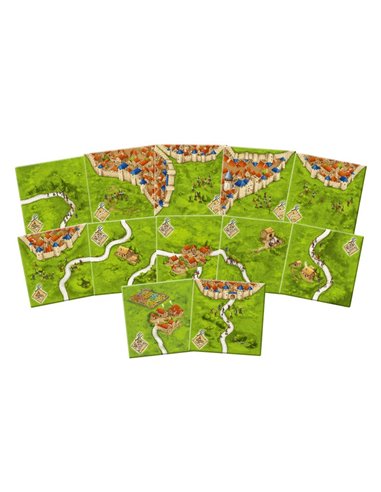Carcassonne mini-uitbreiding: Die Bauernaufstande (EN/DU)
With this mini expansion you have to weigh up whether you want to protect yourself against insurgent farmers or if you let the riots come your way unprepared.
Game components: 12 new land tiles, 1 rule (DE/EN)
—description from the publisher
https://cundco.de/media/pdf/79/65/49/Bauernaufstaende-final-_Regel_D_E_11.pdf
https://wikicarpedia.com/index.php/The_Peasant_Revolts
Carcassonne - Die Bauernaufstande
In this mini-expansion you have to decide, whether you want to protect yourself against insurgent peasants (and hence direct their anger against your fellow players) or rather take things as they come.
This expansion has cities with clipped buildings.
This expansion has been developed for the Carcassonne basic game. All the basic game rules still apply in addition to the expansion rules below. You can combine it with other expansions - but at your own risk – that is, there will be no official rules for these combinations.
Contents
12 new land tiles for peasant revolts with symbols for the respective features.
Peasant Revolts tile
5x cities
4x roads
3x monasteries
Rules
Preparation
Shuffle the 12 land tiles of this mini-expansion. Put 3 of them back into the box (without looking at them). Those tiles will not be used in this game. Shuffle the remaining 9 tiles and the other land tiles together.
Gameplay
1. Placing a tile
The peasants revolt
As soon as you draw a peasant revolt tile, a revolt takes place. Place the tile in front of you. [1] Now check, if one or more of your meeples are standing on features shown on the diamond-shaped symbol of the tile (city, road or monastery), and if those meeples are "unprotected" or "protected".
All of your unprotected meeples on the respective features, must be returned into your supply immediately.
Every protected meeple on the respective features scores 2 points. Protected meeples remain protected after the revolt.
(How you can protect your meeples, will be explained in 2. Placing a meeple.)
Note: If you had to return at least one meeple, the revolt is over and you continue with your normal turn.
Example 1: You draw a land tile with the peasant revolt symbol for roads (symbol enlarged in this example).
Your unprotected meeple is standing on a road on the left. Put the meeple back into your supply. Your protected meeple on the right stays on the tile and scores 2 points.
The revolt is over. The blue meeple has not been affected. Now, place the land tile according to the usual rules and continue your turn.
The peasant revolt moves on to the next player
If you do not have to return a meeple to your supply, because none of your meeples are standing on affected features or because all of your meeples, on affected features, are protected, the peasant revolt moves on and hits the player to your left. They also check, in the same way as described before, whether or not the revolt affects them and if they score points for protected meeples. If they, also are not affected by the peasant revolt, it moves on to the next player.
This continues until a player has to return at least 1 meeple to their supply, or none of the players have been affected. Now, place the land tile according to the usual rules and continue your turn.
Note! Only players, who have to check their meeples during the peasant revolt, score points for their protected meeples. Players who are not hit by the peasant revolt cannot score any points for protected meeples.
Example 2: You draw a land tile with the peasant revolt symbol for cities (symbol enlarged in this example). All of your meeples in cities are protected and you score 4 points.
The peasant revolt moves on to Blue. Blue is sitting to your left, and continues to check, if and how the peasant revolt affects them. Blue has 1 protected meeple in the city on the left, which scores 2 points. The unprotected meeples have to be returned into Blue’s supply. That is how the revolt ends and you place the land tile according to the usual rules and continue your turn.
2. Placing a meeple
Protecting a meeple from a peasant revolt
If you place a meeple on the tile just placed, you may also protect this very meeple, for the cost of 4 points. To do so, move your meeple on the score board back by 4 spaces. It is possible to score negative points. Next, “lay down” this meeple. This meeple has now joined the farmers. [2]
Example: Protecting a meeple
Each time you do not place a meeple on the tile you just have placed, [3] you may protect one of your meeples standing on tiles for the cost of 2 points.
Farmers cannot be protected. They are never affected by peasant revolts.
A meeple “lying down” is protected from a peasant revolt. In case the revolt affects you, you score 2 points for each protected meeple in an affected feature (see 1. Placing a tile).
3. Scoring a feature
When scoring a feature, a protected meeple is treated like a normal meeple. It is returned into your supply after the feature has been scored. After that, it loses its protection from peasant revolts. This means, that if you place that meeple again, it is unprotected once again.
Example: The city has been completed. You have the majority of meeples (2 in this case) and score 10 points.
Blue does not score any points. Return all meeples from the city back into your supplies and place them upright. They are now unprotected once more.
Final scoring
Final scoring is performed according to use usual rules. When scoring a feature, a protected meeple is treated like a normal meeple.



